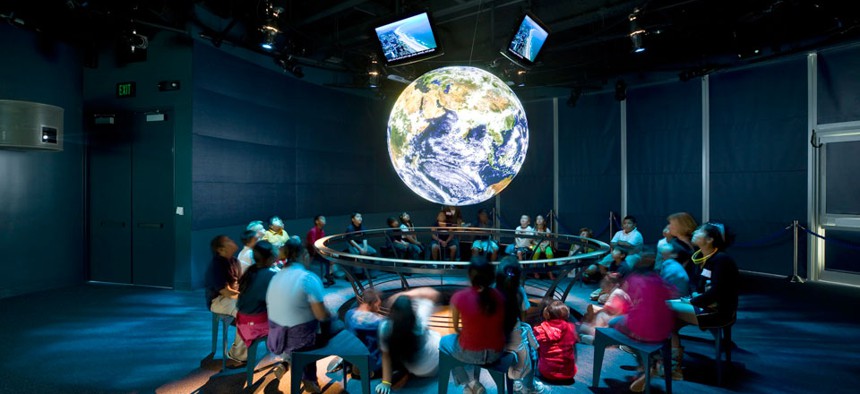Why NASA Made a Movie You Can't Watch at Home

Aquarium of the Pacific/NOAA
Water Falls is a beautiful combination of science and art. But to see it, you'll need some pretty special equipment.
We live in an age where just about any piece of multimedia is available from the comfort of one's living room. Want to watch a recent episode of Girls ? Done . Want to see the Hunger Games ? Easy enough . Yes, sometimes you may need to wait a few months while something is still in the theaters, and sometimes you might have to pay, but in the end, you can watch what you want at home.
But not NASA's newest film, Water Falls , which debuts this weekend in Tupper Lake, New York.
Water Falls , unlike most movies, doesn't project onto a flat, rectangular screen. Rather, it plays on a sphere , specifically, a "Science on a Sphere" globe, developed by NOAA in 2005, which is a 50-pound carbon-fiber ball, about six-feet in diameter. ( Here's a little demo video that shows what this looks like in action.)
Spherical film projection introduces all sorts of problems, which director Michael Starobin sorted into a taxonomy: There's the "problem of non-existence" (how do you make sure the film isn't focused on an object that half the room cannot see?); there's the "problem of the egg" (how can you show not just the surface of the sphere, but what's inside it—say, the core of the Earth?); and there's the "problem of the chair" (the challenge of projecting objects without a funhouse effect).

The problem of the chair (images courtesy of Michael Starobin)
For any landscape, you have to somehow join the left and right edges of a scene together, even if in reality they'd be at opposite ends of your view. For any animation, you have to account for the distortionary effects of being projected onto a screen.
"The biggest question is: What do you do if you have an image that you want to go all the way around the screen, but its of ... a dog? It's not a sphere. What happens?"
Commissioned as part of the education resources around the upcoming joint NASA/ JAXA Global Precipitation Measurement mission, the nine-minute-long Water Falls is an effort to answer those problems. "We don't like to say that these are 'solved.' We like to say that these are refined," Starobin says.
A trailer (meant for viewing on plain old flat screen) gives a flavor of the final product, but can't convey the way the film works in three dimensions. But it does contain some clues: Pay close attention to how the landscape scenes often have very similar left and right edges. That's no accident. Starobin and his team sought out places where, say, a hill on one side rose a similar height to a hill on the left. On the sphere, with some editing sleight of hand, those edges have been seamlessly stitched together so that it can be projected onto a sphere. "The thrill is the chess of how to figure it out," Starobin says.
There are clearly some built-in advantages to spherical films. If you're NOAA, say, and you're trying to understand how weather patterns interact around the globe, projecting weather data onto a sphere makes a ton of sense. After all, a sphere more accurately represents the physical reality of the thing (the Earth) that you are trying to represent. For the scenes of Water Falls that show how satellites cross-cross around the planet's atmosphere, the sphere works more naturally than a traditional flat screen.
But Starobin says there's another advantage to spherical films, one that goes beyond the value of its corpor properties. And that is that you can't have it at home. You have to actually go to a "Science on a Sphere" site— of which there are about 100 worldwide —and then that is your only chance to take it in.
"In this incredibly wired culture, [audiences] can't download it on their phone. They can't see it anywhere else. And so there is a nice sense of destination that always accrues," Starobin says.
On a trip to a sphere in Colorado about a year and a half ago, a couple of local teachers told Starobin that the fact that the experience was rare made their students appreciate it more. "The students knew you can't see this anywhere else," Starobin told me, "and that focused their attention."


